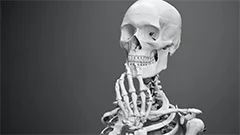Introduction
The study of the ribcage, or costae, is a fundamental aspect of osteology as it provides an essential framework for the thorax, protecting vital organs and facilitating respiration. This comprehensive guide aims to provide an in-depth exploration of the various aspects related to the ribcage, including their number, structure, development, function, and clinical significance.
An Overview of the Ribcage
Definition and Classification
The ribcage (costae) is a complex structure consisting of 24 bones in humans, divided into five categories: true ribs (sternal ribs), false ribs (dorsal or floating ribs), and the last two pairs, known as the lumbar ribs. The first seven pairs are true ribs, with their own costal cartilages that attach directly to the sternum. The next two pairs are false ribs, connected to the true ribs above them via a common costal cartilage, while the final two pairs of ribs (eighth to twelfth) do not have any corresponding costal cartilages.
Development and Growth
The development and growth of the ribcage occur during embryonic and fetal stages, following a specific pattern that can be broken down into several phases:
- The formation of the cartilaginous precursors
- The migration of these precursors to their final positions
- The ossification process, which transforms the cartilage into bone over time
The timing and sequence of these events are crucial for the proper formation of the ribcage, ensuring its structural integrity and functional capacity.
Structural Features of the Ribcage
True Ribs (Sternal Ribs)
General Characteristics
True ribs have their own costal cartilages, which extend from the inferior angle of each rib to the sternum, contributing to the flexibility and mobility of the ribcage during respiration. The first seven true ribs are further classified as the superior, middle, and inferior true ribs based on their specific characteristics and attachments.
Superior True Ribs (1st - 3rd)
The superior true ribs have a flat-shaped head articulating with the vertebral bodies of the thoracic spine. The neck angle is relatively short, providing little mobility. Costal grooves on the inferior surface of these ribs accommodate the intercostal muscles, allowing for efficient respiration.
Middle True Ribs (4th - 7th)
The middle true ribs have a slightly curved head that articulates with both the thoracic spine and the sternum via the costal cartilage. This arrangement increases mobility compared to superior true ribs, facilitating a more efficient respiratory process.
False Ribs (Dorsal or Floating Ribs)
General Characteristics
False ribs do not have direct attachments to the sternum and are therefore known as floating ribs. Instead, they connect to the true ribs above them through a common costal cartilage, making their mobility limited compared to true ribs. The first two false ribs (8th and 9th) possess short and curved heads that articulate with the thoracic spine, while the second pair of false ribs (10th and 11th) lack any heads, attaching directly to the costal cartilages of the true ribs above them.
Lumbar Ribs
General Characteristics
The lumbar ribs (12th to 24th) are the last pairs of ribs in humans and do not have corresponding costal cartilages. They have a broad, flat-shaped head that articulates with the thoracic spine only, providing minimal mobility compared to other ribs.
Functions of the Ribcage
Protection of Internal Organs
The primary function of the ribcage is to protect the vital organs within the thorax, including the heart and lungs, from potential trauma or injury. This protective role is crucial for maintaining overall health and well-being.
Respiration
The ribcage plays an essential role in respiration by expanding and contracting during the breathing process. This movement facilitates the exchange of gases between the lungs and the external environment, enabling oxygenation and carbon dioxide removal.
Clinical Significance of the Ribcage
Fractures and Injuries
Fractures or injuries to the ribs can be painful and debilitating, often requiring medical attention for proper healing and management. Symptoms may include localized pain, difficulty breathing, and swelling at the injury site.
Respiratory Disorders
Various respiratory disorders, such as asthma, pneumonia, or pleurisy, can affect the ribcage's mobility and function, impacting the efficiency of gas exchange within the lungs.
MCQ: Test your knowledge!
Do you think you know everything about this course? Don't fall into the traps, train with MCQs! eBiologie has hundreds of questions to help you master this subject.
These courses might interest you
Create a free account to receive courses, MCQs, and advice to succeed in your studies!
eBiologie offers several eBooks containing MCQ series (5 booklets available free for each subscriber).




